|
Cruise Diary From Alaska
Spectacular glaciers, a private stateroom, and halibut fishing along the Inside Passage are the attraction.
Is there a better way for a couple of resident Floridians to experience Alaska for the very first time than on a luxurious cruise ship? We don't believe
so. There truly are thousands of memories along the Inside Passage, across the Gulf of Alaska and deep into the heart of America's last frontier.
The cruise lines call
Alaska "nature's showplace", and indeed it is. For a couple of outdoor lovers, being partially confined to our transportation and accommodations might present problems.
However, being immersed in a breathtaking environment that is just a glass wall away is a natural "high" that eliminates those concerns.
 Daily stops along the way to experience the unique surroundings is what this trip is all
about. An itinerary that allows flexibility was the type of adventure that could have been custom-designed by us. Daily stops along the way to experience the unique surroundings is what this trip is all
about. An itinerary that allows flexibility was the type of adventure that could have been custom-designed by us.
Arrival
Our flight from Florida arrived at the Vancouver airport in the early afternoon on the Saturday of our cruise departure. Whether by land or sea,
visitors to Alaska must cross Canada, and Vancouver is the most popular jumping off point.
After clearing customs, our bags were properly tagged with Princess Cruise tags and taken
away while we waited in line for the bus to take us to the cruise port. It was a bit of a mayhem, but we finally boarded our bus and, after a 30-minute ride through scenic
Vancouver, we spotted our beautiful ship.
We had planned this trip for nearly a year, and it was well worth the wait. Our schedule on
the Dawn Princess would take us northward through the Inside Passage, reaching Seward after 7 days. Our cabin is perfect, on the starboard side of the ship with a private balcony,
giving us a front row seat to many scenic views as we travel north.
 Naturally, we had to explore every part of the ship, learning the layout and finding our dining room. As this was our second cruise on a 2
,000-plus passenger ship (our first was on the Monarch of the Seas, a Royal Caribbean ship sailing through the Eastern Caribbean), we can't help compare one
to the other. We liked the quarters on the Dawn Princess much better; our cabin seemed more spacious, yet the general ship layout of the Monarch seemed easier for "people" flow
than the Dawn Princess. Naturally, we had to explore every part of the ship, learning the layout and finding our dining room. As this was our second cruise on a 2
,000-plus passenger ship (our first was on the Monarch of the Seas, a Royal Caribbean ship sailing through the Eastern Caribbean), we can't help compare one
to the other. We liked the quarters on the Dawn Princess much better; our cabin seemed more spacious, yet the general ship layout of the Monarch seemed easier for "people" flow
than the Dawn Princess.
Still, we are impressed with the five different dining areas, two show lounges, 24-hour
international food court, the library and the main lobby of the ship. We were full to capacity: 2,100 guests, and the weather, not surprisingly, was not conducive for the pool. Therefore,
most of the guests were milling in various inside areas while the ship slowly departed port.
After quickly unpacking, we went to our early seating and met our dining partners for the
duration of the ship, a well traveled couple in their mid 50's, on their honeymoon. They were nice, but unfortunately we didn't have much in common, so conversation was often difficult.
Returning to our cabin at about 8 p.m. we discovered it was still daylight outside. In fact,
throughout our trip we only had three or four hours of darkness at night. Since our body clock reminded us it was nearly midnight, we called it a day.
Day One
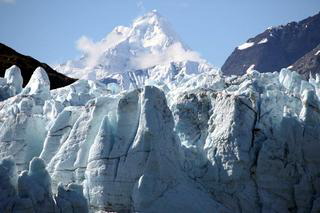 We woke up to beautiful mountain scenery as the ship slowly cruised northward on the first day. We can see small villages, and what
could be hunting camps, interspersed throughout the bays and islands that we pass by. We can also see many small boats and a ferryboat crossing the water, and we realize
that this is a major mode of transportation along this rugged coastline. We woke up to beautiful mountain scenery as the ship slowly cruised northward on the first day. We can see small villages, and what
could be hunting camps, interspersed throughout the bays and islands that we pass by. We can also see many small boats and a ferryboat crossing the water, and we realize
that this is a major mode of transportation along this rugged coastline.
On the map we see the names of several towns, yet we can see only two roads leading
to a couple of them. It would be interesting to talk to the residents of those towns and learn more about their lifestyle, so near to the rest of the world, yet so remote.
After a sumptuous breakfast, we roamed the ship once again. The shops and casinos were open, as is normally the case when the ship is not in port. Surprisingly, the price of
clothing and souvenirs were not as outrageous as we expected. Since the weather continues to be misty and cloudy outside, we enjoyed the vistas from our private balcony. I am
convinced we did the right thing in upgrading to this level of stateroom. We are bound to spend a lot more time in our room than we did on the Caribbean cruise, and we were glad to
have the extra room and the balcony outside the sliding glass doors.
This second day is also the most popular for signing up for shore excursions. Since Larry
and I usually prefer to make our own plans, we decided to wait until we arrived at our first destination.
Day Two - Ketchikan
Our ship had docked while we slept, and we were surprised to see the town at our feet
when we opened our balcony curtain. We could see all the shopping district and most of the town without even stepping off the ship!
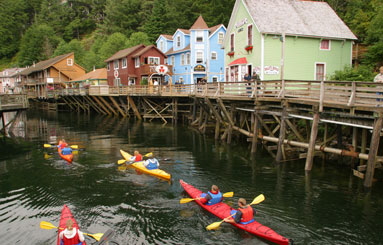 Perhaps one of the most interesting aspects of this town is that it's a linear waterfront city
. Much of its 3-mile long business district is actually suspended above water on pilings driven into the bottom of the river. The edge of town begins at the bottom of the steep wooded hillside
, and the homes perched on the cliffs are reached by climbing long wooden staircases or narrow winding streets. Many of those homes were eye-to-eye with us from the Dawn Princess' berth
as we looked out from our balcony. Perhaps one of the most interesting aspects of this town is that it's a linear waterfront city
. Much of its 3-mile long business district is actually suspended above water on pilings driven into the bottom of the river. The edge of town begins at the bottom of the steep wooded hillside
, and the homes perched on the cliffs are reached by climbing long wooden staircases or narrow winding streets. Many of those homes were eye-to-eye with us from the Dawn Princess' berth
as we looked out from our balcony.
The name Ketchikan was derived from "Kitsch-Hin", the name given by a native Alaskan tribe, the Tlingit. The
word means "thundering wings of an eagle." Originally a home for the Tlingit, they were slowly displaced as gold mining, timber and salmon fishing attracted outsiders.
Ketchikan is the southernmost city in Alaska and the fourth largest, with a population of
14,000. It is the first port of call for cruise ships, with two or three normally docked at the same time. The weather when we arrived was typical of Alaska, with summer highs of 65
degrees F and a light, misty rain. For Floridians like us, it was winter!
Bundled up, we took a short walk along the waterfront to get a feel for the town. It was
evident that most of the business was derived from the short summer cruise season. We stopped at a waterfront coffee shop (espresso bars are big in this state) and the radio was
broadcasting the upcoming cruise ship arrivals with the estimated number of passengers. As we sipped our coffee, we saw the constant activity of float planes taking passengers on
scenic excursions.
On our walk back to the ship we visited several of the numerous souvenir shops by the
dock. Nearly every imaginable item in all price ranges can be found here for tourists. We discovered later that, if you want to shop for trinkets for the folks back home, this is the
best town to do so. Prices at the cruise ports seemed to climb the more we traveled north!
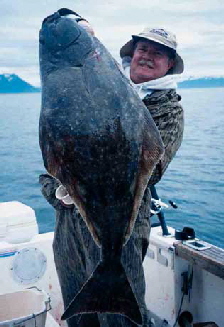 Day Three - Juneau Day Three - Juneau
The town itself was the least scenic of all our cruise ship stops, but for visitors who want plenty of things to see and do
on the numerous shore excursions offered, this can be a perfect location. Halibut fishing charters, sightseeing bus tours, helicopter flights and other options were available to cruise
passengers.
One of Alaska's most popular glaciers is easily accessible from Juneau. Bus tours to Mendenhall Glacier depart soon
after docking. After a short 13-mile ride, visitors can take trails which lead to the edge of the lake to enjoy a fantastic view of the glacier (there are signs warning visitors to stay back from
the edge of the lake, since falling ice can create huge waves). A visitor center at the glacier also offers views of the glacier, guided hikes and video programs.
Downtown Juneau is only a short walk from the cruise ship docks. One of the newest attractions is a cable car ride to the
top of Mount Roberts, which is also accessible by hiking. The observation point is still wild enough that bears are sometimes a nuisance due to garbage
improperly sealed by visitors. On our visit there, the observation point was closed as forest rangers scoured the area for a nuisance bear.
As the capital of Alaska, Juneau offers the typical feel of a large city. Walking through the
congested downtown area finds a mix of modern government buildings and small, picturesque shops trying to capture the image of a remote Alaska village. This was our
shortest landside visit, and we returned to the ship to enjoy quieter surroundings.
Day Four - Skagway
Now we are talking Alaska! There are advantages to having your body clock ahead of
everyone's by three hours, and this morning proved it! We awoke early and, as usual, we first peeked through the curtains. We were greeted by the most beautiful scenery of the trip
yet. Snow-capped mountains were seemingly just a few hundred feet off our balcony, and as we looked behind the ship we could see we were entering an inlet.
The water was literally as smooth as glass, the sun had finally appeared and the clouds
were totally gone. The clearest blue skies reflected on the water, and we felt that we were finally immersed in the Alaskan wilderness.
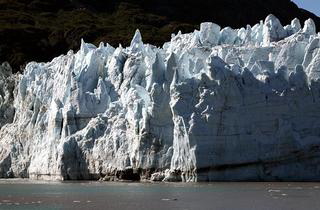 We quickly dressed and went for breakfast to the Horizon Court, which offers a panoramic view of the front of the ship. It was a perfect
way to enjoy a quiet breakfast as we watched our approach to the tiny town of Skagway, population 700! The closest town to Skagway is Haines, 13 miles by boat but 359 miles by
road! This town virtually opens up only for the summer cruise season, with barely 100 people remaining during the winter. We quickly dressed and went for breakfast to the Horizon Court, which offers a panoramic view of the front of the ship. It was a perfect
way to enjoy a quiet breakfast as we watched our approach to the tiny town of Skagway, population 700! The closest town to Skagway is Haines, 13 miles by boat but 359 miles by
road! This town virtually opens up only for the summer cruise season, with barely 100 people remaining during the winter.
It was gorgeous weather, approximately 75
degrees F, and most locals were in shorts and T-shirts. We still wore long pants, but were able to take off our sweaters for most of the day.
Skagway, meaning "home of the north wind," was born of the Klondike gold rush. It became the main entry to the White Pass and Yukon
Trail, booming to 20,000 people in the late 1800's. Walking through the town is a must, as much of the downtown is a historical district with buildings dating to the gold rush times.
To really appreciate the experience of gold rush seekers, visitors must take the White Pass
& Yukon Route train. This three-hour round trip excursion is well worth the cost. Still in operation after 100 years, this narrow-gauge railroad retraces the original route to the
summit of White Pass. From the old-fashioned railroad car, visitors can see the worn path of the original Klondike Trail of 1898.
Placed strategically on the historic trail, items such as old shovels and picks, horse skulls
and gold pans can be photographed from the moving train. To add to the experience, the train passes by Gold Rush Cemetery, over Dead Horse Gulch, past Slippery Rock and over
the depths of Glacier Gorge.
While this excursion can be arranged on the ship, we recommend you walk to the train
depot and purchase your own ticket. Or you can call for reservations at (800) 343-7373. The cost is the same, yet you will probably be scheduled on a separate train and avoid the
huge crowds from the ships. Since they offer open seating, select one of the cars in the center of the train to avoid the diesel fumes from the engine.
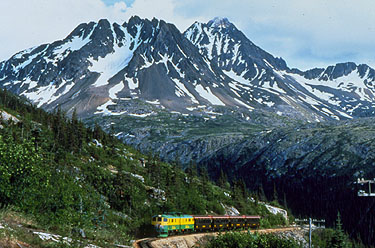 Skagway, as is Juneau, is also an ideal spot to take a helicopter tour. The short one-hour trip includes a 20-minute flight through the
beautiful snow-capped mountains to a nearby glacier. Depending on weather conditions, visitors are dropped off at Ferebee Glacier, Chilkat Glacier or Meade
Glacier, all within view of each other. Once on the glacier, a guide takes you on a short walk. This tour is highly recommended in order to appreciate the numerous glaciers
that can be seen during the following days from the cruise ship. Skagway, as is Juneau, is also an ideal spot to take a helicopter tour. The short one-hour trip includes a 20-minute flight through the
beautiful snow-capped mountains to a nearby glacier. Depending on weather conditions, visitors are dropped off at Ferebee Glacier, Chilkat Glacier or Meade
Glacier, all within view of each other. Once on the glacier, a guide takes you on a short walk. This tour is highly recommended in order to appreciate the numerous glaciers
that can be seen during the following days from the cruise ship.
Walking on a glacier takes on a totally different meaning when you can see the
deep crevasses and the deep blue of the aqua pools right below your feet, while above your head the gigantic chunks of ice are poised, almost ready to crash at any moment.
For such a small town and a short stay, Skagway offers many options. The National Park Service offers a variety of free programs, walking tours and ranger talks on the history of
the gold rush era. Self-guided walking tours of the town and its surroundings are free and give visitors a less commercial experience of the town's history. Regretfully, we walked back
to the Dawn Princess as scheduled for our departure. Somehow, we feel we will return to Skagway again someday.
Day Five - Glacier Bay
 Nothing could have prepared us for this day. Massive snowcapped mountains, walls of
snow and ice, extremely rare, crystal clear blue skies on the glass-like surface of the bay; we were surrounded by a natural wonder that is truly difficult to describe or photograph. Nothing could have prepared us for this day. Massive snowcapped mountains, walls of
snow and ice, extremely rare, crystal clear blue skies on the glass-like surface of the bay; we were surrounded by a natural wonder that is truly difficult to describe or photograph.
The Tlingit Indians called this dramatic attraction "Big Ice Mountain Bay." Simple, but accurate. One of the original explorers, John
Muir, described Glacier Bay as "a picture of icy wildness unspeakably pure and sublime." Again, simple and accurate.
There are no roads to Glacier Bay. A
ranger station at the entrance to the bay, and a lodge, are the point of origin for excursions by land or sea. A ranger boarded the Dawn Princess as we approached Glacier Bay, and his
narrative over the speakers and in-house television channel was a highlight of the experience. Every stateroom also received a map from the National Park Service so that we could
follow the narrative, which we enjoyed comfortably from our balcony.
In the late 1700's, the mouth of the inlet of what is now Glacier Bay was completely
covered by a massive wall of ice which extended northward 100 miles to the St. Elias Mountains. Since then, the glaciers have retreated nearly 65 miles from the mouth of the
inlet, and such a rapid retreat is being studied by scientists, hoping to learn how it relates to climate changes.
Glacier Bay National Park is home to 12 active tidewater glaciers. "Calving" is the term for
huge chunks of ice tearing from the face of the glacier, crashing with a thunder into the water. Glaciers are a result of snowfall in the high mountains exceeding snowmelt. When the
weight of the snow is so great, it becomes solid ice. Eventually, gravity pulls the ice to its
lowest point, bringing soil and debris with it. This debris is called "moraine" and each source of ice sports one. Some glaciers have two or three moraines clearly visible, which indicate
the glacier has two or three sources of ice converging.
The most active glaciers are the Muir, Johns Hopkins and Margerie Glaciers. Even though
we could only view them from 1/2 mile distance, it was easy to see the face of these glaciers were at least 400 feet high and some up to a mile wide. Jagged edges and deep
crevasses were clues of which pieces would be tearing off, perhaps during our watch.
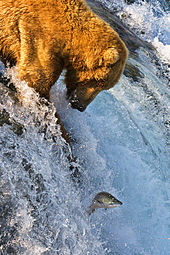 Whether viewing the glaciers from the privacy of our room or joining the crowd on the decks, viewing the glaciers seemed almost a revered moment.
People spoke in hushed voices, and stared transfixed at the fantastic scenery. It was easy to imagine the hundreds of thousands of years
that it took that one chunk of ice to reach the edge of the glacier and finally tear off into the bay. We could hear the thunder of
"calving" many times but could not see their source, so we could only imagine how many other parts of the bay were alive. Whether viewing the glaciers from the privacy of our room or joining the crowd on the decks, viewing the glaciers seemed almost a revered moment.
People spoke in hushed voices, and stared transfixed at the fantastic scenery. It was easy to imagine the hundreds of thousands of years
that it took that one chunk of ice to reach the edge of the glacier and finally tear off into the bay. We could hear the thunder of
"calving" many times but could not see their source, so we could only imagine how many other parts of the bay were alive.
Ice floes of various sizes floated slowly by the cruise ship, and several of them had seals and otters resting comfortably in the sun.
As we very, very slowly cruised into and out of the various inlets of Glacier Bay for several hours, the wonder of the scenery never ceased. Truly an unforgettable Alaskan experience.
Day Six - College Fjord
Another spectacular experience, this one with a twist of humor. We realized that College
Fjord boasts 16 glaciers, each of them named after 16 Ivy League Colleges that funded the expedition that discovered them in 1899. All were impressive and we again were spellbound
watching the glaciers for calving as we cruised slowly by, pausing in front of several. The sun
again provided "professional lighting" for a backdrop of snow-covered mountain peaks and ice blue-webbed glacier snow fields. The scenery was a final, fitting testament to the
wonders of Alaska.
Day Seven - Seward
This is the last day of our cruise. We arrive at Seward and board a bus for a scenic trip to
Anchorage. Not strangely, we paused once on the side of the road to give us a great view of a bull moose wading in shoulder deep water just a few hundred feet away from the road.
Wildlife was evident throughout our Alaskan journey. We noticed many eagles in the skies, a cow moose and her calf crossing the highway, a mother bear and her two cubs on the
side of a mountain, a sea lion rookery, an orca and her baby and many whales in the bays.
After arriving at Seward, I went fishing for some giant halibut and yellowtail. My two
friends and I caught a limit of the "flatsiders" with two weighing 40 pounds each and the giant one pulling down the Valdez dock scales to 105 pounds. After a couple of days visiting
friends in that seaside town we return to very comfortable and affordable accommodations at the new Microtel Inn & Suites near the Anchorage airport. On the following morning, we
boarded our flight with our memory banks full of the beautiful frontier.
Our next trip to Alaska, and there will be a second trip, will most probably be by land, but
that's another story.
|